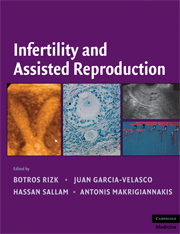Book contents
- Frontmatter
- Contents
- Contributors
- Foreword
- Preface
- Introduction
- PART I PHYSIOLOGY OF REPRODUCTION
- 1 Folliculogenesis: From Preantral Follicles to Corpus Luteum Regression
- 2 Mechanisms of Follicular Development: The Role of Gonadotrophins
- 3 Human Follicle Culture In Vitro
- 4 Endometrial Receptivity
- 5 Molecular Mechanisms of Implantation
- PART II INFERTILITY EVALUATION AND TREATMENT
- PART III ASSISTED REPRODUCTION
- PART IV ETHICAL DILEMMAS IN FERTILITY AND ASSISTED REPRODUCTION
- Index
- Plate section
- References
5 - Molecular Mechanisms of Implantation
from PART I - PHYSIOLOGY OF REPRODUCTION
Published online by Cambridge University Press: 04 August 2010
- Frontmatter
- Contents
- Contributors
- Foreword
- Preface
- Introduction
- PART I PHYSIOLOGY OF REPRODUCTION
- 1 Folliculogenesis: From Preantral Follicles to Corpus Luteum Regression
- 2 Mechanisms of Follicular Development: The Role of Gonadotrophins
- 3 Human Follicle Culture In Vitro
- 4 Endometrial Receptivity
- 5 Molecular Mechanisms of Implantation
- PART II INFERTILITY EVALUATION AND TREATMENT
- PART III ASSISTED REPRODUCTION
- PART IV ETHICAL DILEMMAS IN FERTILITY AND ASSISTED REPRODUCTION
- Index
- Plate section
- References
Summary
INTRODUCTION
Successful implantation requires a functionally normal embryo at the blastocyst stage and a receptive endometrium, while a communication link between them is also vital. This process is a highly regulated mechanism with the involvement of many systems at the paracrine-autocrine levels. Not only human implantation needs this kind of dialogue, but also in other species, like mouse or primates, this cross-communication has been described before (1, 2).
During apposition, human blastocysts find a location to implant, in a specific area of the maternal endometrium. In the adhesion phase, which occurs six to seven days after ovulation, within the “implantation window,” direct contact occurs between the endometrial epithelium (EE) and the trophoectoderm (TE). Finally, in the invasion phase, the embryonic trophoblast breaches the basement membrane, invading the endometrial stroma and reaching the uterine vessels.
The EE is a monolayer of cuboidal cells that covers the interior of the uterus. As a reproductive tract mucosal barrier, EE must provide continuous protection against pathogens that gain access to the uterine cavity, while allowing embryonic implantation, a unique event crucial for the continuation of the species in mammals. Initial adhesion of the TE of the embryo to the EE plasma membrane is the prerequisite for implantation and placental development. EE is a specialized hormonally regulated cell population that must undergo cyclical morphological and biochemical changes to maintain an environment suitable for preimplantation embryonic development.
Keywords
- Type
- Chapter
- Information
- Infertility and Assisted Reproduction , pp. 46 - 52Publisher: Cambridge University PressPrint publication year: 2008



